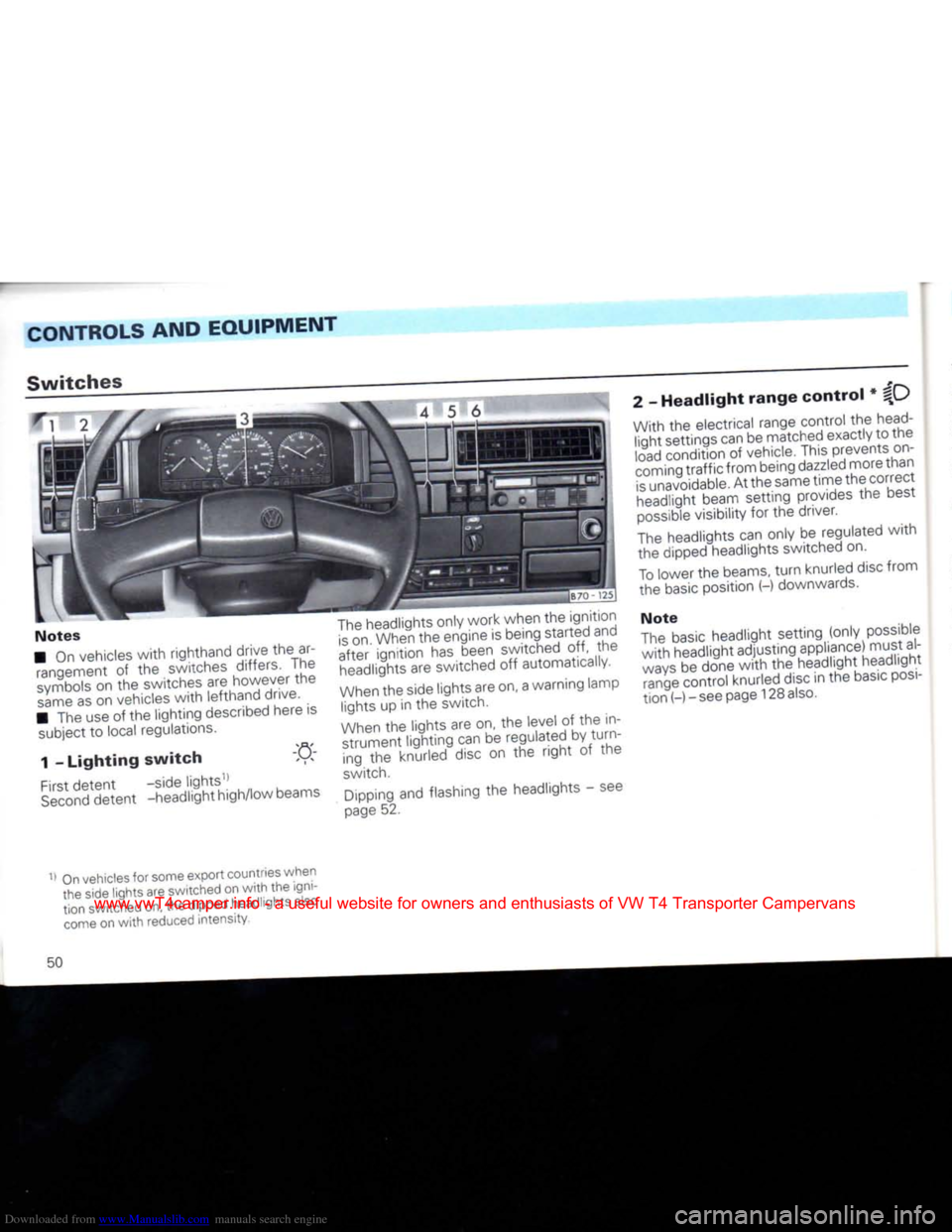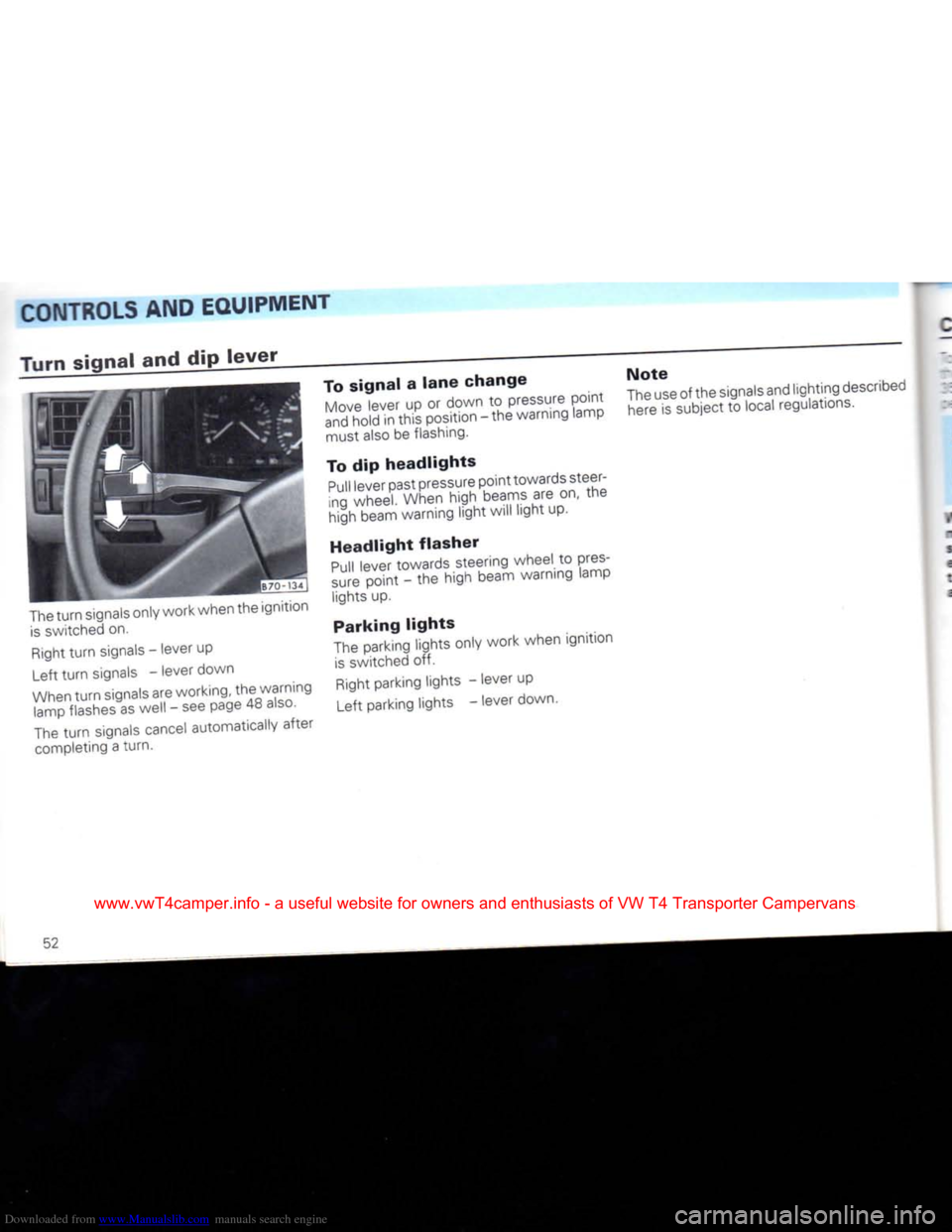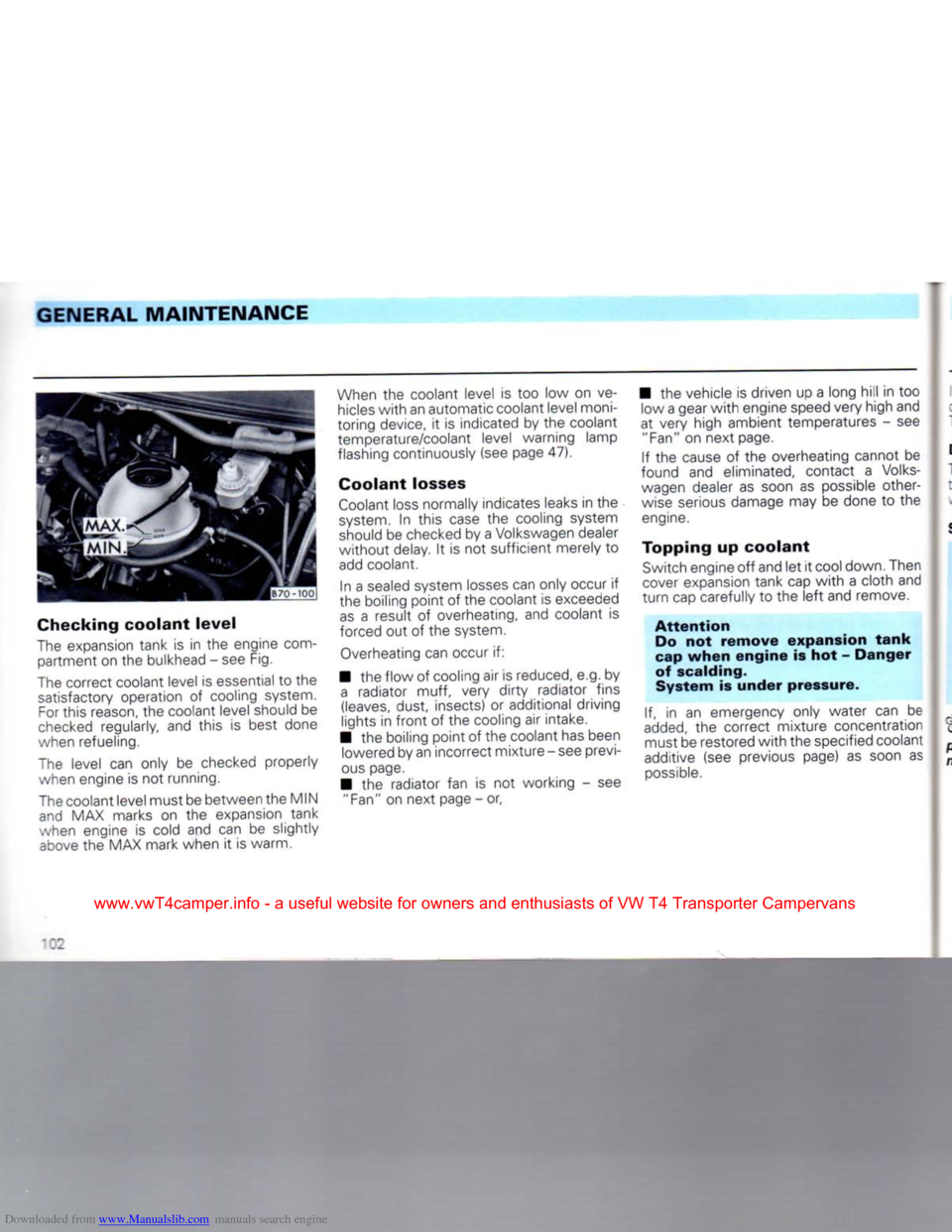1992 VOLKSWAGEN CARAVELLE warning light
[x] Cancel search: warning lightPage 46 of 164

Downloaded from www.Manualslib.com manuals search engine
CONTROLS AND
EQUIPMENT
Miles
(km) - Distance covered
_ne remarks made under "Driving time" also apply in principle to "Distance cov
ered".
The maximum distance indicated is
9999 km or 6214 miles.
MPH
(km/h)
- Average speed
The remarks made under "Average fuel consumption" also apply here in principle.
cfer-
°C _ Engine oil temperature
Oil temperatures (within a range of + 50 de
grees C and + 160 degrees C) are shown.
When no oil temperature indication is
shown,
the engine is still not warm, and it
should not therefore be worked hard. The engine speed should be reduced if the oil
temperature rises to + 145 degrees C. of* -• -
«>*
'i* - Ambient temperature
The measuring range is from - 40 degrees
C to + 50 degrees C..
When the vehicle is stationary or only moving very slowly, the indicated tempera
ture could be slightly higher than the actual ambient temperature due to heat radiation
from the engine or use of the auxiliary heater.
Attention If the ambient temperature read
ing is used as an ice warning, re
member that ice can form on the road at temperatures above 0 C.
Note Both temperatures are momentary values.
They are not stored in the memory.
44
www.vwT4camper.info - a useful website for owners and enthusiasts of VW T4 Transporter Campervans
Page 50 of 164

Downloaded from www.Manualslib.com manuals search engine
CONTROLS
AND EQUIPMENT
The
warning lamp flashes when ignition is
switched
on. the lamp must go out when
engine
has started.
If the warning lamp does not go out or
flashes
when driving - a buzzer also sounds
at engine speeds above 2000 rpm - stop,
switch
engine
off, check oil level and if
necessary,
add oil - see page 97.
If the lamp comes on although the oil level
is
in order, do not
drive
on. Do not even
run the engine at idling speed-call in expert
assistance.
Note
The oil pressure
warning
lamp
is not an oil
level
indicator.
The oil
level
should
therefore
be checked at reg
ular
intervals,
preferably
every
time
the
fuel
tank
is filled.
3 -
High
beams 10 4 - Turn signals
The
warning lampflashes when
turn
signals
are
switched on. If a
turn
signal fails, the
warning lamp flashes twice as fast. (Not
when towing a trailer).
Further
details are given on pages 49
and
52. 5 -
Brake
system «^
The
warning lamp comes on when
• the handbrake is on
• the brake fluid level is too low
The
ignition must be switched on.
Attention
If the
lamp
does not go out
when
handbrake
is released or comes
on
when
driving, the
fluid
level
in
the reservoir is too low. If an in crease in
pedal
free
travel
is no
ticed
at the same
time,
one of the
brake
circuits may
have
failed.
You can
drive
on
carefully
to the
nearest
Volkswagen
dealer
but
allow
for
higher
pedal
pressures and longer
braking
distances on
the way.
The
warning lamp comes on when high
beams
are on or when the headlight flasher
is
used.
48
www.vwT4camper.info - a useful website for owners and enthusiasts of VW T4 Transporter Campervans
Page 51 of 164

Downloaded from www.Manualslib.com manuals search engine
CONTROLS
AND
EQUIPMENT
6-Alternator
Q
~ne warning lamp comes on when the
igni-
I
on
is
switched on and must go out when
She
engine
is
started.
i the warning lamp comes on when driving,
stop,
switch
engine
off
and
check
the
alternator V-belt.
f the V-belt
is
broken or loose do not
drive
on with
a
vehicle which
has a 4 cylinder
engine
because the coolant pump
is
then
no
longer being driven. The V-belt must
be
tensioned
or
renewed.
ehicles with
a 5
cylinder engine
can
nor
mally
be
driven to the nearest Volkswagen
dealer when
the
V-belt
is
broken
or
loose oecause
the
coolant pump
is
driven separ
ately but then the battery will discharge
con
tinuously
and all
non-essential electrical consumers should
be
switched
off.
f the warning lamp comes on although
the
belt
is
not broken, one can normally drive on
to
the nearest Volkswagen dealer (all engine
types)
but the
battery will then discharge
continuously
- see
previous paragraph.
7-Glow
plugs
W
(Diesel engines only)
When
the engine
is cold
the warning lamp comes on when key
is
turned to Drive
posi
tion
(ignition on).
If
the warning lamp does not come
on,
there
is
a
defect in the glow plug system
-
call
in
expert assistance.
When
the
lamp goes out,
start
the engine
immediately
-
see page
38.
When
the
engine
is warm the
glow plug
lamp
does
not
come on -the engine can
be
started straight
away.
(®)
-
Anti-locking
Brake
System
(ABS)*
The operational readiness
of the
essential electrical components
of the ABS are
checked,
both before moving off and when
driving,
by an electronic monitoring system.
The warning lamp lights up when
the
igni
tion
is
switched on and
it
must go out again, at the latest, after the engine
has
started.
If
the warning lamp does not go out
or if it
comes on when driving the system
is
not
in
order.
The
vehicle can then only
be
braked
with
the
normal system
-
that
is
without
ABS-.The vehicle must be taken to a Volks
wagen Dealership
as
soon
as
possible.
Further details on ABS
is
given on page
30.
<]1i>
-
Trailer
turn
signals
The warning lamp
*
flashes when turn
sig
nals are switched on when towing
a
trailer.
If a
turn signal fails on the trailer or vehicle,
the warning lamp does not flash.
www.vwT4camper.info - a useful website for owners and enthusiasts of VW T4 Transporter Campervans
Page 52 of 164

Downloaded from www.Manualslib.com manuals search engine
CONTROLS AND EQUIPMENT
JB70-
1251
Switches
Notes
• On vehicles
with
righthand drive the ar rangement of the switches differs. The
symbols
on the switches are however the
same
as on vehicles
with
lefthand drive.
• The use of the lighting described here is subject to local regulations.
1 -
Lighting
switch
-n
First
detent -side lights11
Second
detent -headlight high/low beams
The
headlights only work when the ignition
is
on. When the engine is being started and
after ignition has been switched off, the headlights are switched off automatically.
When
the side lights are on, a warning lamp lights up in the switch.
When
the lights are on, the level of the in strument lighting can be regulated by turning the knurled disc on the
right
of the
switch.
Dipping and flashing the headlights - see
page
52. 2 -
Headlight
range
control
* %\_)
With the electrical range control the
head
light settings can be matched exactly to the
load
condition of vehicle. This prevents on
coming traffic from being
dazzled
more than
is
unavoidable. At the same time the correct headlight beam setting provides the best
possible
visibility for the driver.
The
headlights can only be regulated
with
the dipped headlights switched on.
To
lower the beams,
turn
knurled disc from
the
basic
position (-) downwards.
Note
The
basic
headlight setting (only possible
with
headlight adjusting appliance) must al
ways
be done
with
the headlight headlight range control knurled disc in the
basic
posi
tion (-) - see page 128
also.
On
vehicles for some export countries when
the side lights are switched on
with
the igni
tion switched on, the dipped headlights also
come
on
with
reduced intensity.
50
www.vwT4camper.info - a useful website for owners and enthusiasts of VW T4 Transporter Campervans
Page 53 of 164

Downloaded from www.Manualslib.com manuals search engine
CONTROLS
AND
EQUIPMENT
3
-
Emergency lights .
nen the emergency lights are on, a warn-
'z lamp in the switch flashes as well.
Ine system also works when the ignition is
;
.-.itched off.
4
-
Knurled wheel for seat
^Jf
heating*
~~e cushion and backrest of the
front
seats
:
=
n
be heated electrically when the ignition
s
on.
_~e
heating is switched on and regulated .vth the knurled wheel.
•
switch heating off,
turn
knurled wheel to
:_e
left
to the detent position.
5
-
Heated rear window
QpJ
The
heating works only when ignition is on.
When
heater is on a lamp in the switch lights up.
As soon
as
window
is
clear,
switch element
off. The
reduced
current consumption helps
to re
duce
the
fuel
consumption
- see
also
page
80.
On
vehicles
with
electrically adjustable ex
terior mirrors the mirrors are heated as long
as
the rear window heating is switched on.
6
-
Fog lights •/
|Q
Rear fog light
First
detent - fog lights
Second
-
front
and rear fog
detent lights, or rear fog
light
only
At the second position a warning lamp in the switch comes on.
The fog lights
work
with
the side lights (ignition on), low or high beams.
The rear fog light
works only
with
the fog lights or
with
the low or high beams.
Due
to the amount of
dazzle
it
causes
the
rear
fog
light
should only be switched on
when the visibility is very poor (in Germany
for example, below 50 metres).
Note
The
electrical system of the factory
fitted
tow bar* is wired-up so
that
when towing
a
trailer
fitted
with
rear fog lights, the rear
fog
light
on the towing vehicle are automati
cally
switched off.
51
www.vwT4camper.info - a useful website for owners and enthusiasts of VW T4 Transporter Campervans
Page 54 of 164

Downloaded from www.Manualslib.com manuals search engine
CONTROLS
AND EQUIPMENT
Turn signal and dip
lever
The
turn
signals only work when the ignition
is
switched on.
Right
turn
signals - lever up
Left
turn
signals - lever down
When
turn
signals are working, the warning lamp flashes as well - see page 48
also.
The
turn
signals cancel automatically after
completing a turn. To
signal
a
lane
change
Move
lever up or down to pressure point
and
hold in this position - the warning lamp must also be flashing.
To dip
headlights
Pull
lever past pressure point towards steer
ing wheel. When high beams are on, the
high beam warning light will light up.
Headlight
flasher
Pull
lever towards steering wheel to pres
sure
point - the high beam warning lamp lights up.
Parking
lights
The
parking lights only work when ignition
is
switched off.
Right
parking lights - lever up
Left parking lights - lever down. Note
The
use of the signals and lighting described
here
is subject to local regulations.
52
www.vwT4camper.info - a useful website for owners and enthusiasts of VW T4 Transporter Campervans
Page 62 of 164

Downloaded from www.Manualslib.com manuals search engine
CONTROLS
AND
EQUIPMENT
Notes
Pools of
water
under
the
vehicle
• When the ambient temperature is high
and
the air very humid, condensed water
can
drip off the evaporator and form a puddle under the vehicle. This is quite nor
mal
and does not indicate a leak.
Operating
faults
• Should the air conditioner not work at
any
time, either:
- the ambient temperature is below about + 5 degrees C,
- the fuse has blown.
Check
fuse and if necessary renew it - see
page
122. If the trouble is not due to
a
defec
tive fuse, switch the system off and have it
checked.
- the air conditioner has switched off due to the coolant temperature being too high -
see
page 41
also.
• If the cooling
output
drops off, switch the
A/C
off and have the system
checked.
Using air
conditioner
economically
In cooling operation the air conditioner
com
pressor
places demands on the engine and
therefore influences the fuel consumption.
To
keep the period switched on as short as
possible,
the following points should be
noted:
• If the inside temperature is very high after the vehicle has been parked in the sun, it is recommended to open doors or win
dows
briefly to enable the hot air to
escape.
• The air conditioner should not be
switched
on during a journey if the windows
or
sliding/tilting
roof*
are open.
• If the desired interior temperature can be attained
without
switching on the air condi
tioner, the fresh air operation should be se
lected.
Recirculating
air
switch
If badly contaminated air is to be prevented
from entering the vehicle, e.g. when driving
through a tunnel, the recirculating air switch in the instrument panel can be
pressed.
When
the recirculating air system is
switched
on, a small warning lamp lights up in the switch.
However,
the recirculating air system
should
only be used for a short period other
wise
the windows will mist up.
60
www.vwT4camper.info - a useful website for owners and enthusiasts of VW T4 Transporter Campervans
Page 104 of 164

Downloaded from www.Manualslib.com manuals search engine
GENERAL
MAINTENANCE
Checking
coolant
level
The
expansion tank
is in the
engine
com
partment on the bulkhead
-
see Fig.
The
correct coolant level
is
essential
to
the satisfactory operation
of
cooling system.
For
this reason, the coolant level should
be
checked
regularly,
and
this
is
best done
when refueling.
The
level
can
only
be
checked properly
when engine
is
not running.
The
coolant level must be between the MIN
and
MAX marks
on the
expansion tank
when engine
is
cold
and can be
slightly
above
the MAX mark when
it
is warm.
When
the
coolant level
is too low on ve
hicles
with
an automatic coolant level moni
toring device,
it is
indicated by the coolant
temperature/coolant level warning lamp
flashing continuously (see page 47).
Coolant
losses
Coolant
loss normally indicates leaks in the
system.
In
this
case
the
cooling system
should
be checked by a Volkswagen dealer
without
delay.
It is
not sufficient merely
to
add
coolant.
In
a
sealed system
losses
can only occur
if
the boiling point
of
the coolant is exceeded
as
a
result
of
overheating, and coolant
is
forced out
of
the system.
Overheating can occur
if:
• the flow
of
cooling air is reduced, e.g.
by
a
radiator
muff,
very
dirty
radiator fins
(leaves,
dust, insects)
or
additional driving
lights
in
front
of
the cooling air intake.
• the boiling point
of
the coolant has been lowered by an incorrect mixture
-
see previ
ous
page.
•
the
radiator
fan is not
working
- see
"Fan"
on next page
-
or, • the vehicle
is
driven up
a
long hill
in too
low a gear
with
engine speed very high and
at very high ambient temperatures
-
see
"Fan"
on
next page.
If
the
cause
of the
overheating cannot
be
found
and
eliminated, contact
a
Volks
wagen dealer
as
soon
as
possible other
wise
serious damage may
be
done
to the
engine.
Topping
up
coolant
Switch
engine
off
and let
it
cool down. Then
cover
expansion tank cap
with
a
cloth and
turn
cap carefully
to
the
left
and remove.
Attention
Do
not
remove
expansion
tank
cap
when
engine
is
hot
-
Danger
of scalding.
System
is
under
pressure.
If, in an
emergency only water
can be
added,
the
correct mixture concentration must be restored
with
the specified coolant
additive (see previous page)
as
soon
as
possible.
•02
www.vwT4camper.info - a useful website for owners and enthusiasts of VW T4 Transporter Campervans